FRIDAY
AUGUST 31 - 2012
HAYLING
ISLAND
Wheatears
Jean and I walked
round Gunner Point and along the beach on West Hayling
this morning. The highlight of the walk was the
Wheatears - at least 20 - that were flying around the
beach and perching on the golf course fence and on
beach bushes like this one with Ryde on the Isle of
Wight in the background.
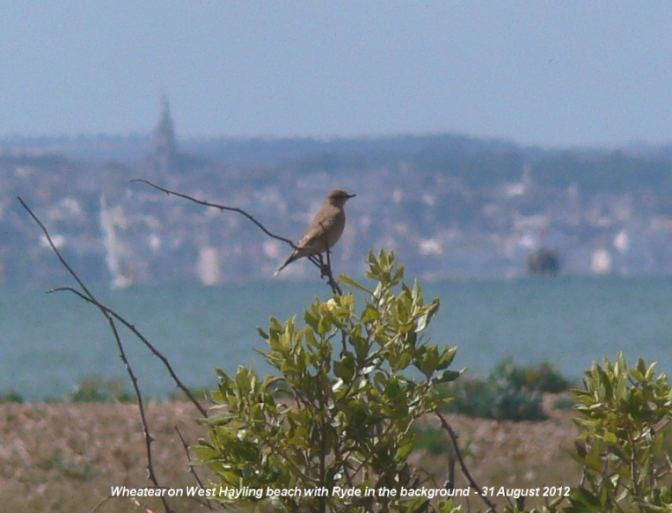
These birds are now on
migration from their breeding grounds further north
and on their way to the wintering grounds in tropical
Africa. Hayling Island is always a good place to see
them on passage.
There were also plenty
of Swallows flying around, occasionally perching on
the golf club fence feeding youngsters.
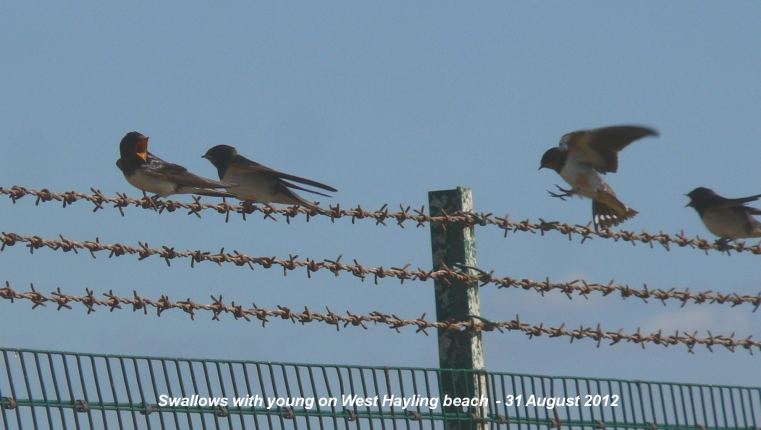
Common
Blues
We saw several species
of butterfly during the walk, including Large White,
Red Admiral and some tatty Meadow Browns. But Common
Blues were certainly the most numerous, feeding on the
rapidly diminishing sources of nectar on the beach
area.

Fragrant
Virgin's Bower Clematis flammula
Walking down the
footpath from the beach to Ferry Road alongside the
golf course we came across a mass of highly aromatic
scrambling white flowers with thin petals.
Martin Hampton thinks
it is Clematis flammula which is scented. It is also
known as fragrant virgin's bower.
Wikipedia adds: It is
native to southern Europe and northern Africa, but it
is cultivated worldwide as an ornamental plant in
gardens. The woody vine bears fragrant white flowers
and small green achenes. When the flowers are newly
opened they have a strong sweet almond fragrance. The
vine grows in a tangled mass that is heavily sprinkled
with flowers throughout the warmer months. It is
popular with gardeners as a decoration along fences
and trellises, or as ground cover. If the vine has no
other plants or structures to climb on, it will climb
on itself, forming a large, densely tangled bush. The
plant sends out many shoots and can reach over five
meters in height. It is sweet-smelling but poisonous.
In some areas, this species has become a nuisance
after its introduction. It is a weed outside of
gardens and landscaped areas. Clematis flammula var.
maritima is a hardier variety that is adapted to sand
dunes. It is currently being studied as an agent of
soil stabilization on eroded sandy beaches.
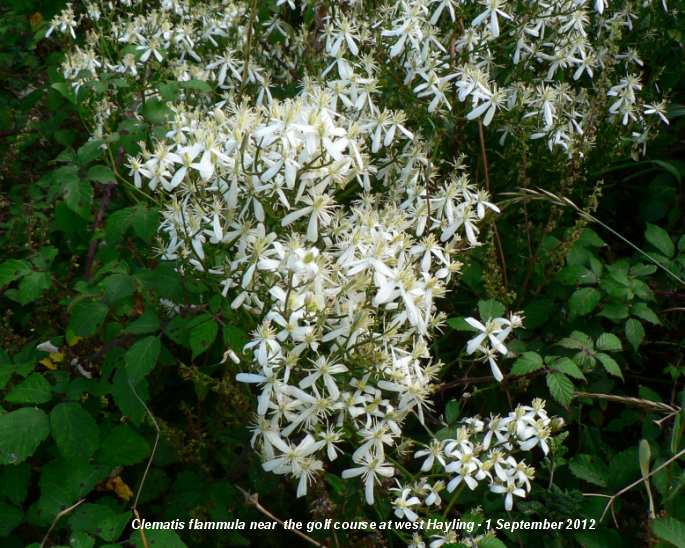
WARBLINGTON
FARM
Mystery
grass
Ralph Hollins came
across a mystery grass on the Conigar Point field of
Warblington Farm, which has recently had its wheat
harvest cut. I went over to have a look for myself
this afternoon. Ralph's grasses were scattered around
the field, but mostly at the edges and looked very
fresh.
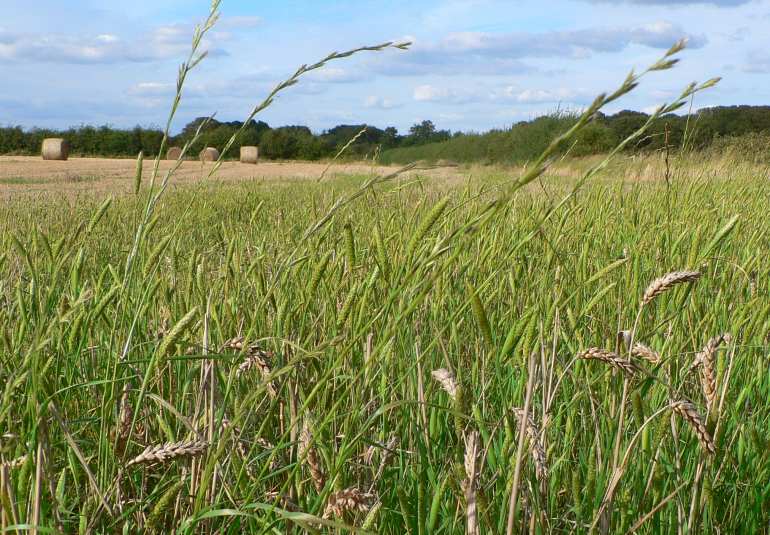
I pulled up a couple
and they came up quite easily with a few shallow roots
and no obvious rhizomes or stolons. The panicle was
cylindrical rather like Timothy, but not so large and
far more regular in length at 4-5cm. The spikelets
were fresh green and awnless and looked nothing like
those of Timothy or Meadow Foxtail. The ligules
varied, but were generally short and ragged. I looked
through my copy of Cope and Gray (Grasses of the
British Isles) without finding anything like it. One
thought I had was that they might be a new growth of
Wheat which was the harvested crop of the field.
THORNEY
ISLAND
Tony Wootton was on
the west side of Thorney Island this morning and got
some photos from between the Little and Great Deeps.
'Silver Y Moth, a spider building a nest, two pics of
a female common blue, a small copper, small heath and
a dragonfly. Tony thought it could be an Emperor or a
Southern Hawker. It looks a bit like a Common Hawker
to me.
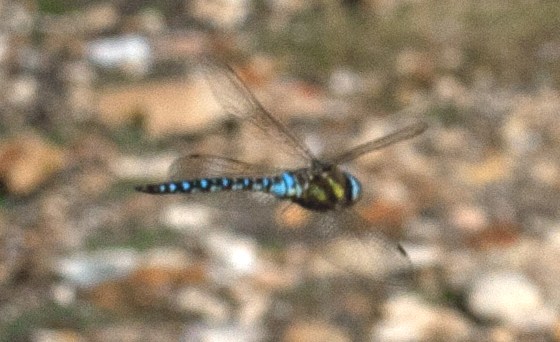
BROOK
MEADOW
Malcolm Phillips was
back on Brook Meadow this afternoon and captured this
nice image of a Meadow Grasshopper - a very common
insect on Brook Meadow in high summer.

LANGSTONE
HARBOUR
Chris Cockburn reports
on the state of the breeding seabird colonies:
At the Hayling
Oysterbeds, there has been no loss of chicks by
predation or territorial attacks over the last 5
weeks. Results at Oysterbeds, so far: Oystercatchers -
3 nests produced 1 fledged youngster (probably the
only one in the harbour this year). Black-headed gulls
- 28 nests produced 63 fledged youngsters (many from
broods of 3) - compare with earlier 67 from 1000+!.
Common terns - 49 'apparent' nests counted earlier;
but later monitoring gave only 18 nests with hatched
chicks (mostly singles but 5 doubles); given the
weather conditions this year, it is likely that some
of the 49 were having me on!; however, up to 5 weeks
ago, there was significant predation by crow on
'north' island. Assuming no disasters, the breeding
season should end around mid-September when most of
the common tern fledglings will start their journey to
W Africa without any intensive training in flying and
food-catching skills.
The harbour-islands'
breeding season ended in 3rd week of July (as per
normal) with 12 black-headed gull fledglings and 2
Mediterranean gull fledglings - there were no
fledglings for Sandwich, common or little terns,
oystercatchers or ringed plovers.
WEDNESDAY
AUGUST 29 - 2012
Great
Black-backed Gulls
I spotted two juvenile
Great Black-backed Gulls in the low water channel
close to Emsworth Marina this afternoon. They are most
likely to be the ones from the Slipper Millpond nest.
So they are still hanging around. There was no sign of
the adults, though I did see one adult back on Slipper
pond last Sunday along with a juvenile.
House
Martins
Paul Cooper sent an
update on the House Martins nesting in his Funtington
house (but not this year - previously reported on June
20): "Although birds never returned to nest on our
house for the last few days there have been 20-30
martins almost constantly flying over our garden and
Lynch Down; at one point last weekend there were up to
100. Presumably they are gorging on insects prior to
migrating. Hopefully they will return to nest next
year." Thanks Paul and keep in touch.
SUNDAY
AUGUST 26 - 2012
EMSWORTH
Great
Black-backed Gulls are back!
When I went past the
pond this afternoon I spotted two Great Black-backed
Gulls, one adult and a juvenile on the south raft.
They were almost certainly from the family that nested
here, but probably just on a nostalgic visit and not
to stay. Here is the juvenile looking very fine in its
developing plumage.
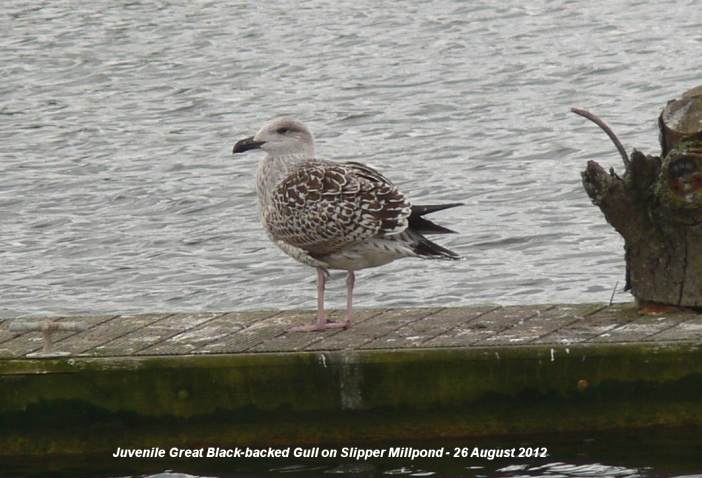
Roesel's
Bush-cricket
Malcolm Phillips went
around Brook Meadow today and captured this image of a
Roesel's Bush-cricket with the distinctive green sweep
around the pronatal flap showing well. The only
previous sighting of this insect was in June 2010 by
entomologist Bryan Pinchen.
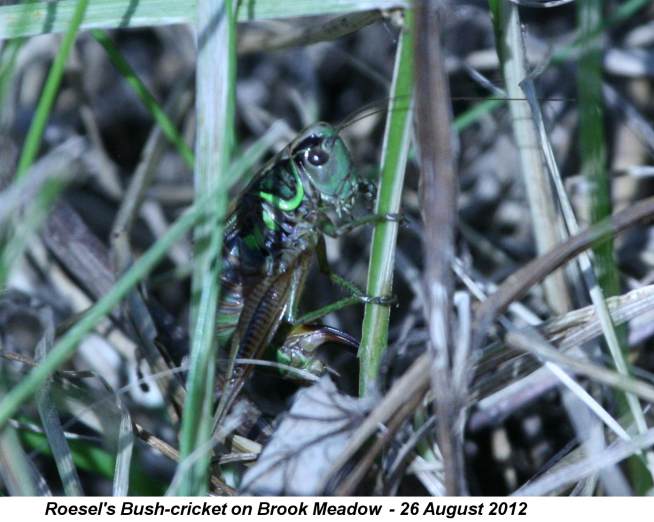
Grey
Dagger Moth
Jill Stanley found
this caterpillar scaling the wall of her house in
north Emsworth yesterday afternoon. She iddentified it
as the larva of the Grey Dagger Moth. She says it
likes to feed on willow, hawthorn, and blackthorn, of
which she has none in her garden!

New
Zealand Pigmyweed
I asked Martin Rand
about the plant that I found in a New Forest marsh on
Aug 22 that I thought might be Marsh Speedwell. He
said it was a very invasive acquarist's throw-out
called New Zealand Pigmyweed (Crassula helmsii). So
much for my plant ID skills!
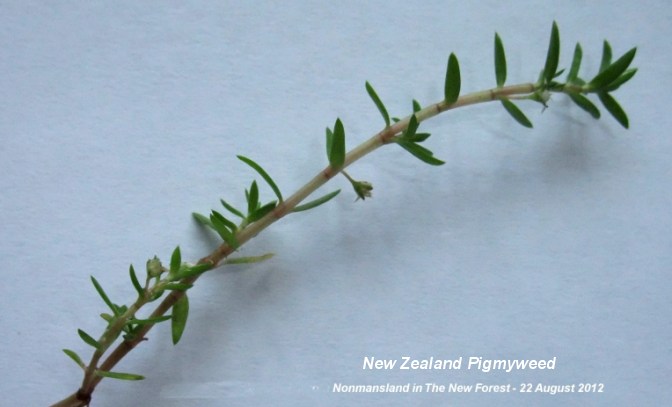
Nore
Barn Woods News
Good news from the
Nore Barn Woods Conservation Group is that all finance
for phase one of the shoreline protection work has now
been raised and work will commence in September. On
Saturday 8th Sep there will be a Special Workday to
clear the scrub along the unprotected gap.
FRIDAY
AUGUST 24 - 2012
EMSWORTH
Slipper
Millpond
Coots are amazing
birds. They never give up. After a traumatic
breeding season due to the nesting Great Black-backed
Gulls gobbling up their young, a pair are trying again
in the nest box on the northern raft. It is very late
in the season, but now the gulls have left, who knows?
There is no nesting in the other two nest boxes on the
millpond.
Golden Samphire
is now in full flower both on the Hermitage Bridge and
along the western path overlooking Dolphin Lake.

Waysides
News
For today's news from
the Emsworth waysides go to . . . http://www.emsworthwaysides.hampshire.org.uk/few-NEWS-current.htm
CAROLINE'S
NEWS
Hedgehogs
Caroline French has
been caring for her local Hedgehogs. "I have been
putting out dried chicken-based hedgehog food and
kibbled peanuts (never whole peanuts as these can
apparently become lodged in their mouths, preventing
them from feeding) and water. It is all being eaten
but I hadn't seen a hedgehog for some time. Last night
at around 10 pm I looked out and saw an adult hedgehog
feeding from the plate for at least 15 minutes. It
then headed purposefully for the bottom corner of the
garden where we have a wooden hedgehog house
positioned behind a plastic compost bin. I had a look
at the hedgehog house this morning and there are
promising signs that a hedgehog has taken up residence
- there are a few trails of grass as though bedding
materials have been dragged there, and a certain whiff
of hedgehog!
This is at least the
second hedgehog to have made use of facilities in our
garden this year and we are always really pleased to
see them. It just goes to show that even a small
garden can provide a home for these animals if you are
prepared to leave a sheltered, undisturbed area for
them. We also leave two or three square metres of
uncut long grass which I know they make use of to
search for food. No doubt any grass verges which are
left uncut are also of benefit to them. A smallish
wooden panel lodged securely at an angle against a
fence or wall could also provide shelter for a
hedgehog to build a home under - a cheaper option than
buying a purpose-built hedgehog house".
Orange
Swift moth
Caroline found a moth
in her house in North Emsworth on the 19th Aug which
she took it into the garden and released it. She
thinks it is an Orange Swift moth (Hepialis sylvina).
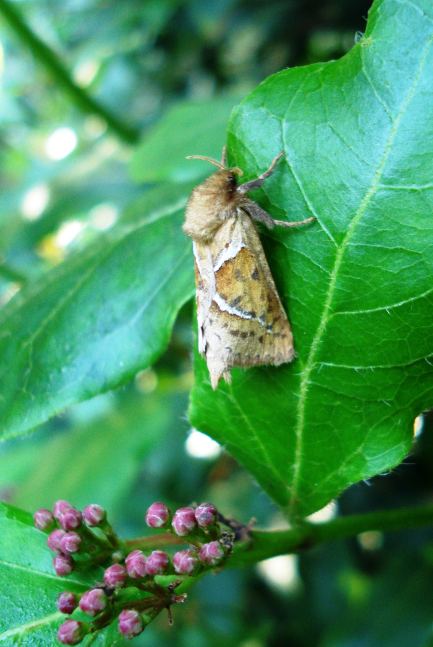
Roesel's
Bush-cricket
Yesterday Caroline was
on chalk grassland near Twyford, when a Roesel's Bush
Cricket (Metrioptera roeseli) hopped onto her FSC
Grassland Plants ID chart. Maybe the illustrations are
too realistic! I always look for the green stripe
around the pronatal flaps to identify this insect.
What a smasher!
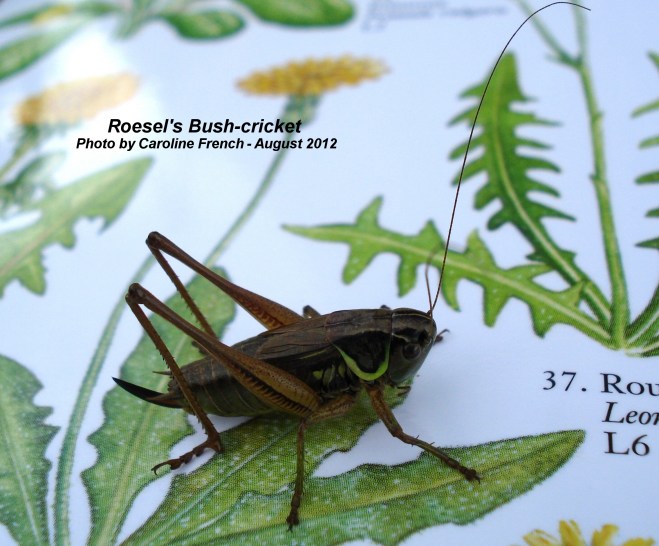
Brent
Lodge
Caroline also provided
the following information about the Brent Lodge
Wildlife Hospital
You can download the
Summer 2012 News Update from Brent Lodge at . . .
http://www.brentlodge.org/downloads/august2012.pdf
There is a Grand Open
Weekend at Brent Lodge on 25th & 26th August.
Address: Brent Lodge Wildlife Hospital, Cow Lane,
SidleshamChichester, West Sussex PO20 7LN
THURSDAY
AUGUST 23 - 2012
NEW
FOREST
Yesterday (Aug 22),
Jean and I stopped for a picnic lunch at Nomansland in
the New Forest on our way home from holiday in
Clevedon. We had a short walk through this beautiful
woodland where we found masses of Tormentil flowering
on the grassy areas. Quite near to the car parking
area was an area of boggy ground covered with two
plants including Water-pepper. The other main plant I
could not identify.
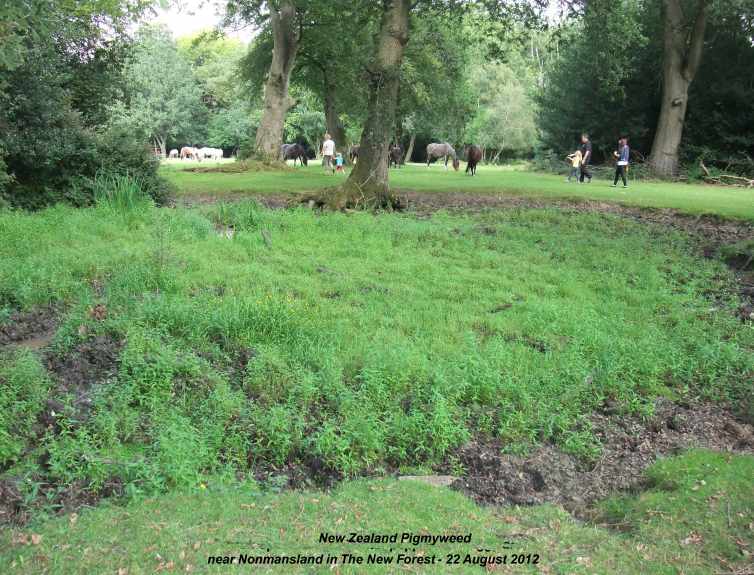
New
Zealand Pigmyweed
- Crassula helmsii
I brought a piece of
the unidentified plant home with me. It was very
slender with whitish flowers and narrow opposite
lanceolate leaves. I am grateful to Martin Rand for
its identification as New Zealand Pigmyweed (Crassula
helmsii) - a very invasive acquarist's throw-out

BROOK
MEADOW
Plants
(Observations from yesterday)
Hoary Ragwort -
This handsome plant is now in full flower in the
orchid area on the north meadow, probably the best
flowering in this particular area that I have seen. It
has been able to climb above the rampant vegetation
that has tended to stifle smaller plants in this area
this year. Hoary Ragwort appears to have gone from
other areas of the meadow where it previously
flowered.
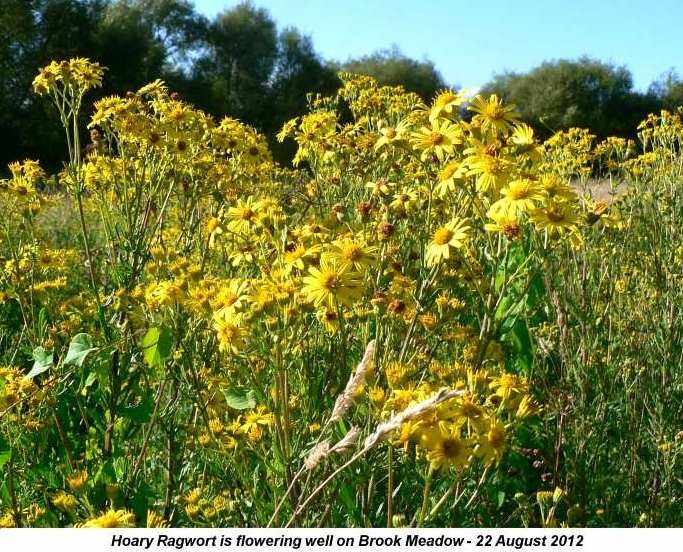
Strawberry Clover
- The plants on the path round the east side of
the Lumley area are now showing the strawberry shaped
fruits, though not the full colour as yet.
Pepper-saxifrage
- There are now 7 tall plants in full flower in the
usual spot on the east side of the Lumley area. This
is down on last year's total of 24 plants, though
numbers do tend to vary from one year to the next.
This is the only place this unusual umbellifer grows
on Brook Meadow.
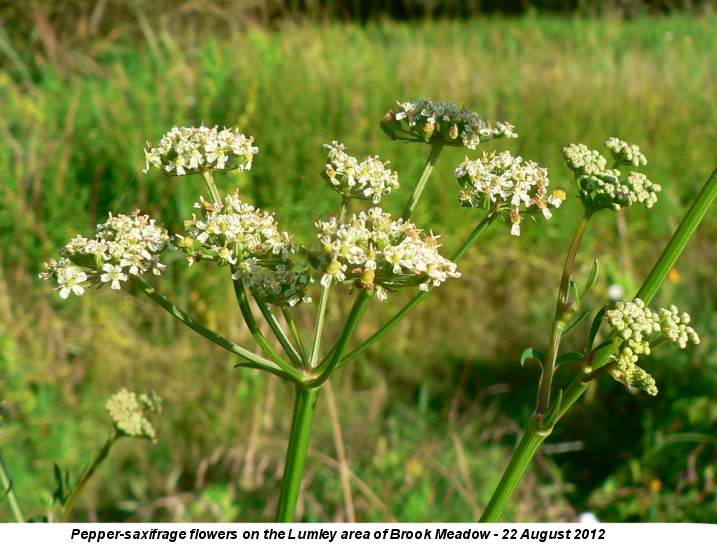
Marsh Woundwort
- The count of these plants at the north end of the
Bramble path keeps going up each time I look. Today I
counted 20 flowering spikes pushing their way through
the dense vegetation. But there is no sign of the
Tufted Hair-grass which usually manages to push its
way through the tangled masses in this spot.
Wild Angelica -
The plants growing on the south meadow seem to get
taller every time I walk down the Bramble path. Some
of them are certainly twice my height ie a good 11
feet.
Birds
Birds are not very
obvious anywhere at present as they are in moult after
the end their breeding season and are generally
keeping their heads down. However, Malcolm Phillips
managed to catch sight of a few on Brook Meadow today
including this nice Long-tailed Tit.
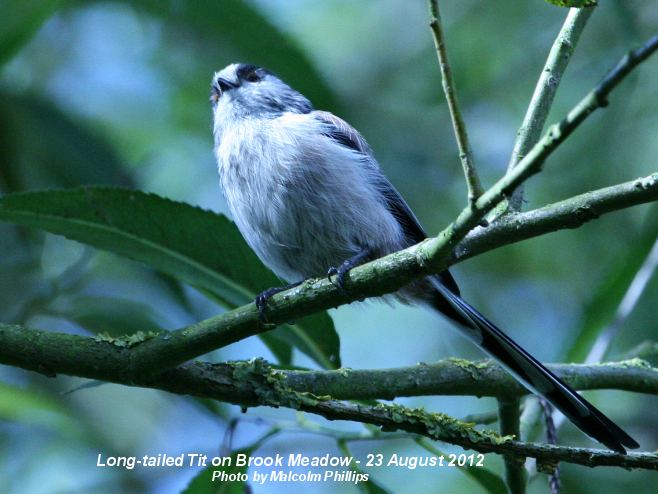
Other
plant news
(Observations from yesterday)
Narrow-leaved
Water-plantain - There is currently a good
flowering of Narrow-leaved Water-plantain in the
Westbrook Stream below the Victoria Road bridge (south
side). But generally this year, this plant has
suffered from the flooding during June when most of
the plants were washed away.
Michaelmas
Daisies - These attractive plants are now in
flower on the south bank of Peter Pond close to the
A259 road. They always flower earlier on Peter Pond
than on Brook Meadow where it will probably be a week
or two before we see any flowers.
Common Reed -
The Common Reeds are now looking quite superb with
their reddish flower spikes, on the west side of Peter
Pond on the path to Gooseberry Cottage. Such a
handsome plant.
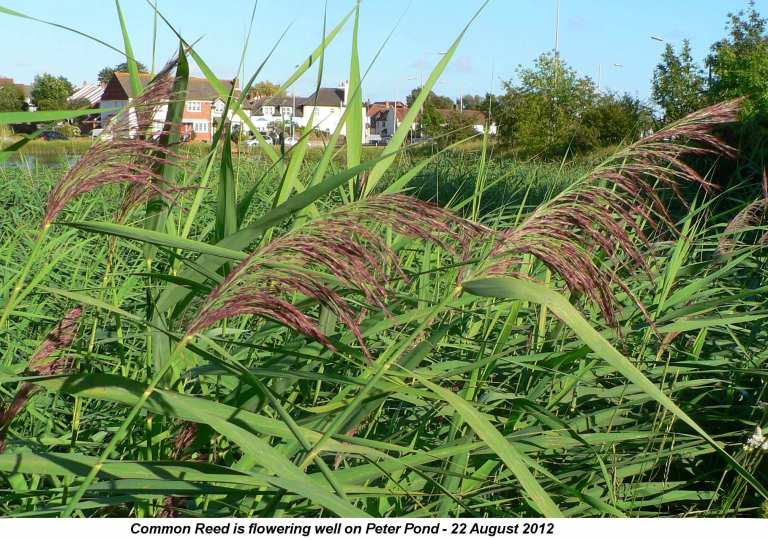
AUGUST
19-21 - 2012
I had the following
sightings reported to me during the few days I was
away from home.
BROOK
MEADOW
Plants
Flowering
Maurice Lillie spotted
the following plants in flower on Brook Meadow for the
first time this year on August 22.
Broad-leaved
Everlasting-pea on the Seagull Lane patch. This is
a regular in this area every year, but this year it is
very late coming out, probably due to the clearance of
vegetation by the conservation group in spring.
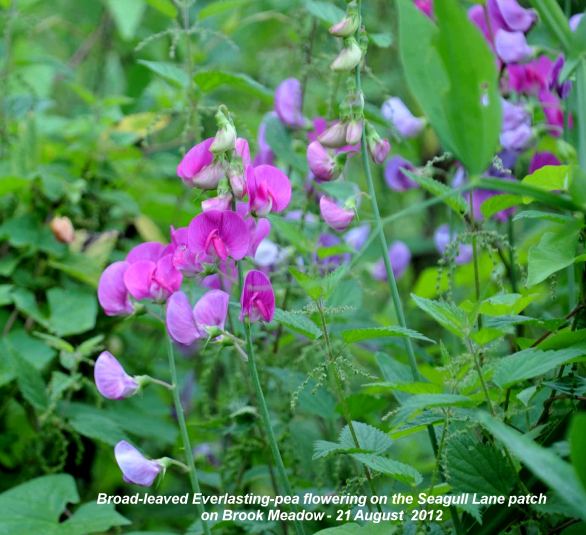
Amphibious Bistort
- a plant which rarely flowers, though this year
there are several plants with flower spikes on the
edge of the path that crosses west of the Lumley area.
I have also seen it out in other areas outside Brook
Meadow.

Common
Darter
Brian Lawrence snapped
this male Common Darter on Brook Meadow on August 21.
Fairly common on Brook Meadow at this time of the
year.

OTHER
NEWS UP-DATES
Silver-spotted
Skipper
A Silver-spotted
Skipper was seen and photographed by Mike Wells at
Grandfather's Bottom, behind Butser Hill. The
distinctive silvery patches on the underwings are
clearly visible in Mike's photo.
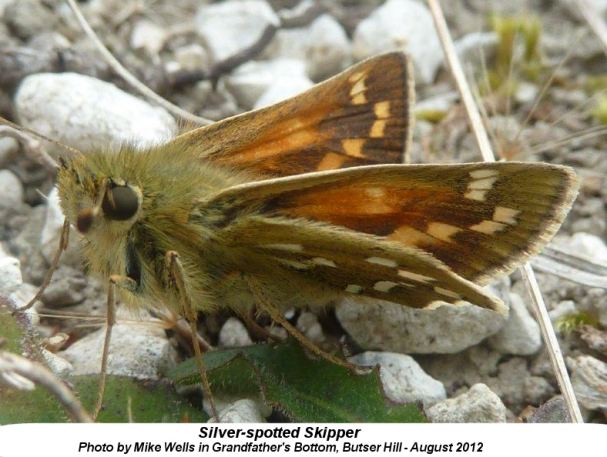
This is a rare
butterfly which is restricted to chalk downs in
southern England where it can be seen darting low over
short turf, stopping frequently to bask on bare ground
or feed on flowers such as Dwarf Thistle. The
Butterflies of Hampshire says that a population of was
introduced into the Queen Elizabeth CP in the 1990s
and I assume Mike's insect derives from this
introduction.
Clouded
Yellow
Tony Wootton got this
fine image of a Clouded Yellow Clouded yellow taken on
his mobile phone, next to the Eastern Thorney security
gate on 20 August. This was the first Clouded Yellow
that I have had reported to me locally.
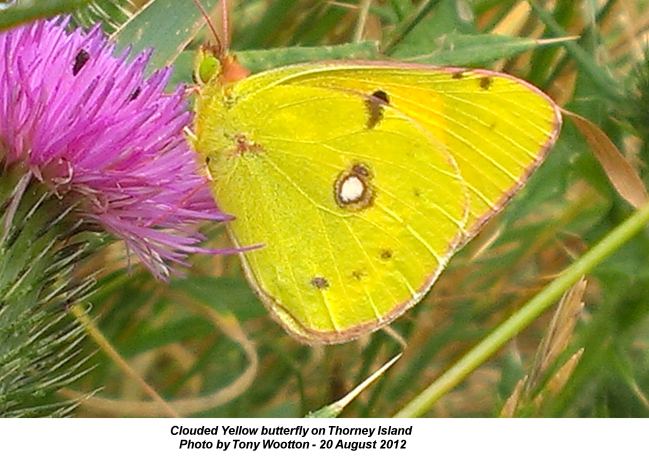
SATURDAY
AUGUST 18 - 2012
Dusky
Slug?
Caroline French thinks
the slug in Malcolm Phillips's photo of the Toad on
Brook Meadow on Aug 16 could be a Dusky Slug, rather
than a Leopard Slug.

She says it looks
quite different to the Leopard Slug that she saw in
Havant Thicket during a Havant Wildlife Group walk a
couple of weeks ago, but does look like the Dusky Slug
photo on the Defra-linked webpage. This slug also has
stripes. Here is the link to this very useful page for
slug identification: http://adlib.everysite.co.uk/adlib/defra/content.aspx?doc=178453&id=178456
Here is the photo of
the Dusky slug from the web site and I agree with
Caroline that the Brook Meadow slug does look more
like this than the Leopard slug. However, whatever the
creature was it is probably no longer with us as it
was being eyed as a tasy meal by the Toad.
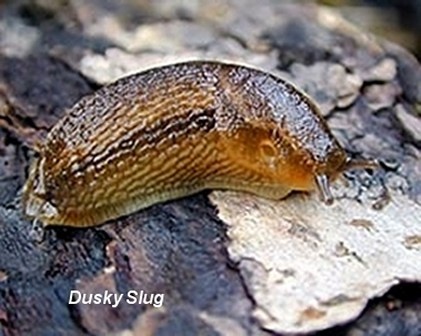
Dusky Slug
(Arion subfuscus) is a moderate slized slug,
reaching up to 7cm at maturity, and is common in most
parts of the UK. It favours woodlands, hedgerows and
can also be found in gardens and allotments. The body
is a pale shade of brown but with darker lengthwise
strips. It can look more golden in colour due to
orange body mucus. It has a yellow sole and sole mucus
is colourless.
Leopard Slug
(Limax maximus) is a large slug - up to 16cm in length
- which has distinctive black leopard like marking on
its upper body. Its underside is white. It has a
pronounced keel along the rear of its body. Mucus is
sticky and colourless. Widespread and common in the UK
favouring woodland and gardens. Low risk to
agricultural crops.

Caroline also draws
our attention to the Open Air Laboratories (OPAL)
'Bugs Count' survey, where they are requesting
sightings of Leopard Slugs. There is a map showing
reported sightings so far. Caroline has already
reported the Leopard Slug they saw in Havant Thicket
a, although she didn't manage to successfully upload a
photo. See . . . http://www.opalexplorenature.org/LeopardSlug
FRIDAY
AUGUST 17 - 2012
BROOK
MEADOW
Insects
Tony Wootton spent
some time in Brook Meadow yesterday pm. It was very
quiet for birds and butterflies. So he spent his time
photographing insects. Here is a Meadow
Grasshopper - very common on Brook Meadow. The
only non-flying British grasshopper. Note its very
short wings.

Tony also got an
assortment of flies. Here is a couple. He thinks the
black/white striped fly is a flesh fly. The green one
is a Green Bottle.
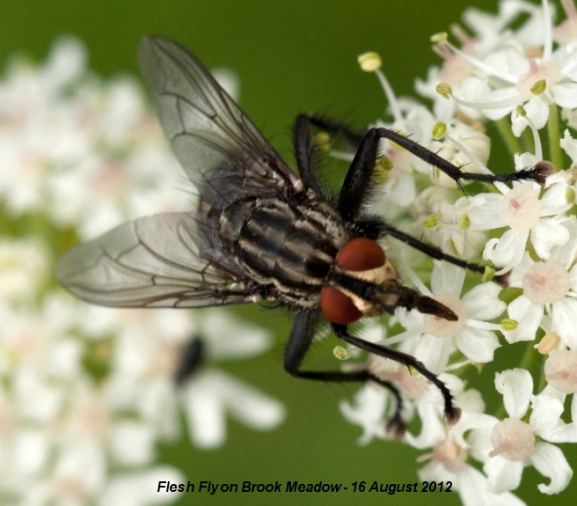
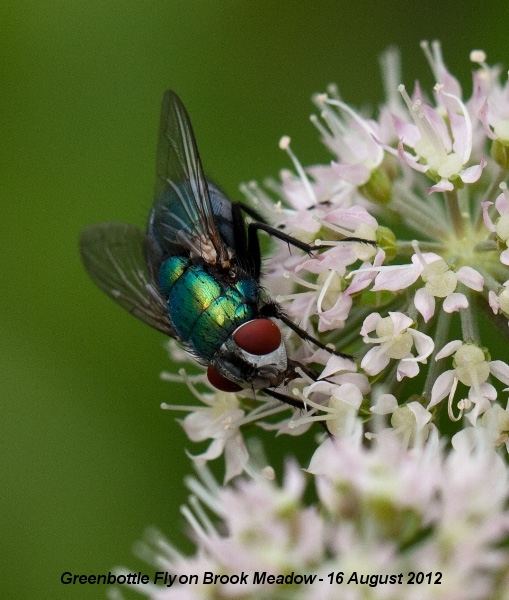
Leopard
Slug
Ralph Hollins was
intrigued by the colour bands on the slug in Malcolm
Phillips's photo of the Toad on Brook Meadow
yesterday. He says. "Most slugs do not have patterns
on their bodies though they may be variously coloured
(same all over) but if you look at . . .
http://en.wikipedia.org/wiki/Limax_maximus
you will see a very
similar colour banding on the body of the Great Grey
or Leopard Slug which is our largest species (can grow
to 8 ins) but is very rarely reported. I have only
seen one once (Havant Thicket in Aug 2008) and the
only other report is the one you published in the
Wildlife Group walk report for Aug 4. Brook Meadow
should feel honoured to have our native 'biggest
slug'."
THURSDAY
AUGUST 16 - 2012
BROOK
MEADOW
Conservation
work session
I went over to the
meadow after visiting the dentist this morning mainly
to take photos of the conservation work session which
was going ahead at full steam when I arrived.
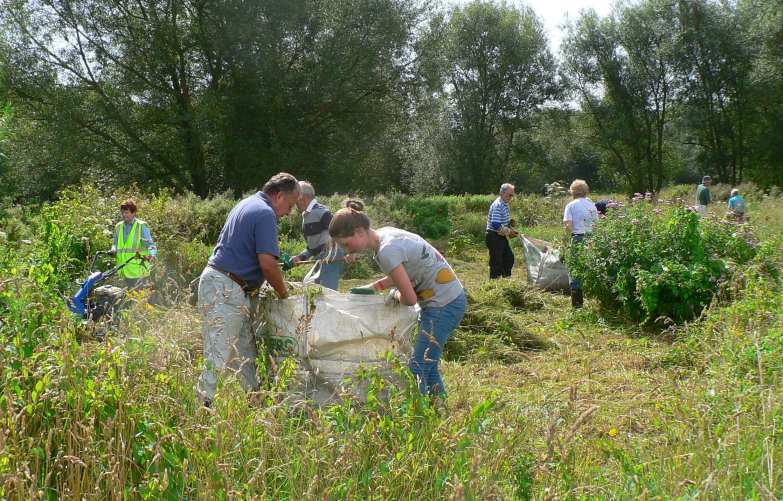
It was good to see
three young volunteers hard at work, Helen, Beth and
Nicholas, National Citizen Service participants under
the guidance of team leader, Jackie Burden. The main
task was cutting and clearing the central part of the
north meadow - ie the orchid area - which had become
very overgrown this year with grasses and bindweed. A
few islands of flowering plants and other vegetation
were kept as refuges for insects and other wildlife.
Hoary Ragwort and Hemp Agrimony, both in full flower,
were also spared in the cutting.

Wildlife
On one of the islands
of vegetation I spotted what I think was a female
Dark Bush-cricket lumbering around. It stopped
briefly for a photo before leaping off. This was our
first sighting on Brook Meadow since 2009.

Malcolm Phillips sent me
the following photo of a Toad eyeing up a tasty
looking slug. Ralph Hollins thinks the slug could be a
Leopard Slug which is our largest species (can
grow to 8 ins) but is very rarely reported. See
tomorrow's entry for comments by Ralph Hollins.

Malcolm also captured
this excellent picture of a Holly Blue butterfly
showing the black spots on its underwing, clearly
distinguishing it from the Common Blue.
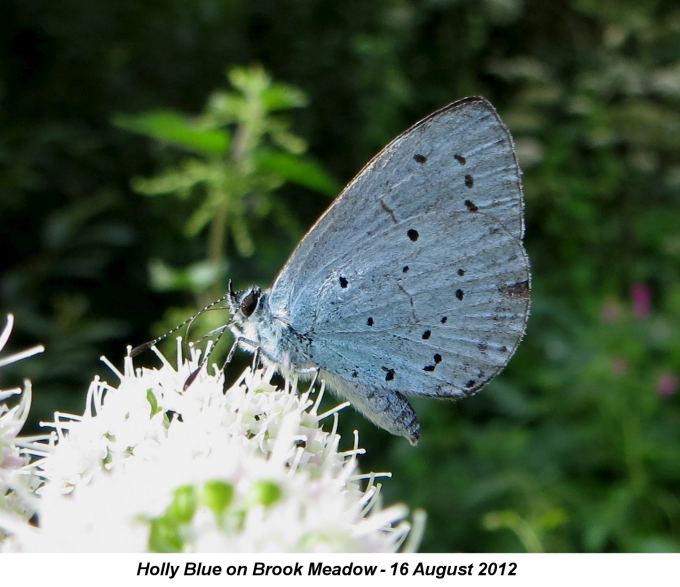
TUESDAY
AUGUST 14 - 2012
FISHBOURNE
MEADOWS
I had a very pleasant
mooch around Fishbourne Meadows this afternoon after
taking Jean over to a WI Quiz at North Mundham. I was
quite surprised at how wet the ground was, quite boggy
in places. Sharp-flowered Rush was far more abundant
than it is on Brook Meadow with more tall fleshy
leaves and bright red inflorescences. I saw my very
first Amphibious Bistort in flower! There were
plenty of Meadow Brown butterflies, more than I have
seen for a while.
Marsh
Willowherb
I was pleased at last
to discover what I think was Marsh Willowherb
(Epilobium palustre) flowering on the eastern meadow.
The plants were fairly tall (30-40cm) with tiny pink
flowers at the end of multiple branches. The plant
seemed to fit all the characteristics mentioned in the
flower guides; erect, slender, cylindrical stem
without ridges and with appressed hairs, narrow
strap-shaped leaves, small flowers with club-shaped
stigmas. This was my first ever Marsh Willowherb after
some false alarms in previous years. I could not
photograph the plant successfully in the field, so
here is one I brought home with me.

Marestail
on Fishbourne Millpond
I went over to the
millpond mainly to have a look at the Marestail
which grows in abundance on the pond. A Coot pair had
two very young chicks on the pond and a Mallard had a
brood of six ducklings.

There is a huge and
very handsome Gunnera plant on the side of the stream
near the kissing gate leading from the meadows to the
millpond. The large flower spikes are forming. Right
next to the Gunnera there is a common Water-plantain
(Alisma plantago acquatica) in flower. This plant has
broad lanceolate leaves unlike the more scarce
Narrow-leaved Water-plantain that we have growing in
the Westbrook Stream here in Emsworth.
Appledram
Lane (south)
I had a quick look at
the Appledram Lane (south) verge. The Spiked
Star-of-Bethlehem was well over, but I did spot a few
remaining flowers of the Hairy Bindweed.
Silver
Y Moth
I spotted a moth
fluttering around in the vegetation. I did not know
what species it was, but Ralph Hollins says it is what
always used to be called a Gamma Moth because that
mark on the wing is in the shape of a Greek Gamma.
Nowadays they have Anglicized its name to Silver Y -
see http://ukmoths.org.uk/show.php?id=1134
I should have known it as we had one recorded on Brook
Meadow on June 6 2010.
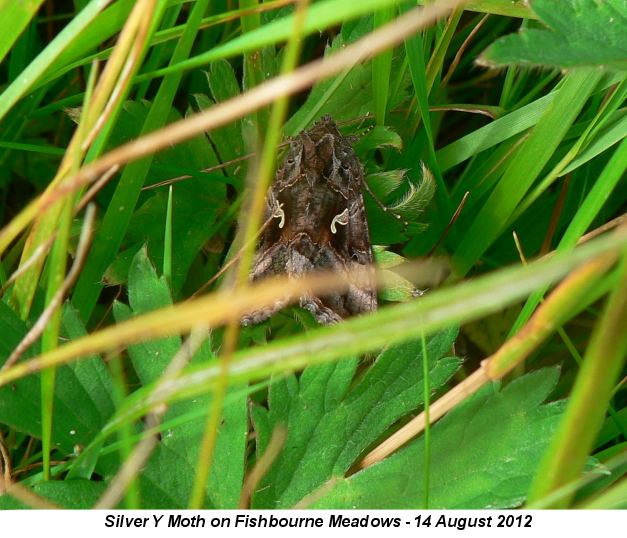
They can be abundant
immigrants in some years and are seen by day
fluttering rapidly around in grassland - you were
lucky to get one to stand still. Frequenting a range
of suburban habitats, including gardens, waste ground
and roadside verges, the adults are on the wing in
July and August, and frequently visit the garden
moth-trap. The larvae feed on a wide range of garden
and wild plants.
BROOK
MEADOW
Malcolm Phillips is
back from Cuba and getting back into local life. He
went round the meadow this afternoon and saw a Buzzard
at the north end and on the way back got two
Sparrowhawks having fun. He also saw a Moorhen that
seems to like blackberries. Welcome back Malcolm.
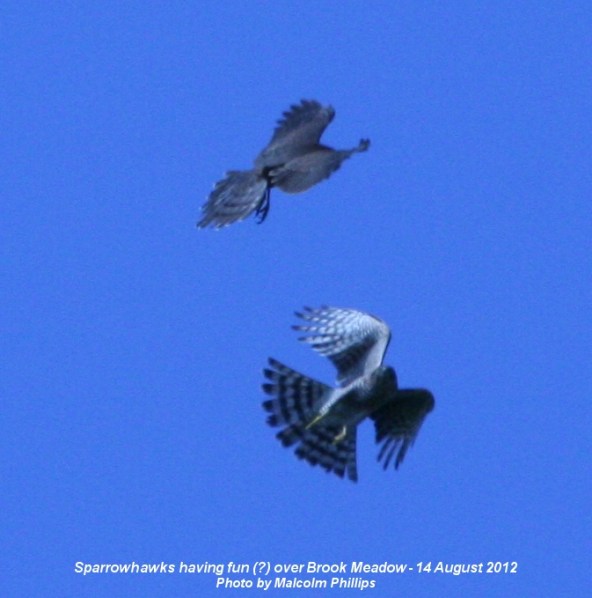
MONDAY
AUGUST 13 - 2012
EMSWORTH
RAILWAY STATION NORTH
Jane Brook and I
carried out a preliminary management session this
morning on the new wayside area of by the new ramp on
the northern side of Emsworth Railway Station. To read
about the new plants discovered on this exciting
wayside and the visit of Ralph Hollins please go to
the waysides blog at . . . http://www.emsworthwaysides.hampshire.org.uk/few-NEWS-current.htm
FRIDAY
AUGUST 10 - 2012
BROOK
MEADOW
River
bank cutting
The Environment Agency
have been on Brook Meadow and have cut the east bank
of the river for about 30 metres south of the north
bridge. But that is all they seem to have done apart
from a bit of clearance around the sluice gate. I
assume they are coming back to finish the job.
However, the bank they have done has been cut right
down to the edge of the river, without leaving the one
metre strip that the Brook Meadow Conservation Group
agreed with them some years ago should be left as a
refuge and feeding ground for the Water Voles.
Pam Phillips saw the
E.A men arrive on Thursday morning. There were 4 of
them and at 8am were just walking down the river. She
called across to establish who they were and asked if
they were doing their annual clearance. They replied "
just doing a bit of strimming ". Pam asked if Wally
knew they were there and their reply was typically
vague. Pam said there are tracks down the bank in
various places and they seem to have cut one branch
and left it on the west bank just north of the
bulrushes. She doubts they will be back and I agree.
They have done this on several occasions before, just
coming in, doing a 'bit of strimming' then leaving.
Wild
Angelica
What has been the
Hogweed show on Brook Meadow is fast becoming the Wild
Angelica show as these huge plants really get into
their stride. Walking up the Bramble path from the
south gate you will find some giant plants already
well over 10 feet tall on the south meadow.
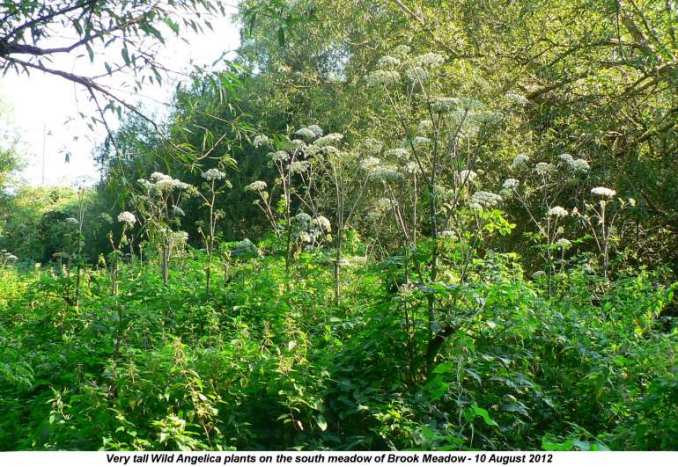
They have smooth
reddish stems in contrast to the green rough stems of
Hogweed. There is more Wild Angelica on the Lumley
area, though of more modest size. Both plants are a
great nectar source and attract a array of insects.
There are also several flowering plants of Wild Teasel
along the Bramble path.
WEDNESDAY
AUGUST 8 - 2012
EMSWORTH
A
new wayside
Terry Green (Southern
Railway Manager) and Lorraine Clode (Emsworth
Residents Association) agreed that the land north of
the new ramp at Emsworth Railway Station should be
left as a natural wildlife area and that the Friends
of Emsworth Waysides should manage and maintain it.
Jane and I agreed to monitor the wildlife on the site
as we do the other waysides with regular litter picks.
The site requires minimum management, but the spread
of the brambles does need controlling.
After the end of the
meeting Jane and I had another look around the site
and discovered nine more plants to take the list for
this site to 91. Two plants we were not expecting were
Pale Flax and Common Gromwell on the
embankment near the ramp. We hope we have got the IDs
of these two plants correct! Advice welcome. We also
located three more plants of Sharp-leaved Fluellen.
CORRECTION
-
Martin Rand comments
Your Pale Flax has a
rather "lippy" asymmetrical looking flower and
similarly rather lop-sided seed capsules - also just a
few leaves from the axils of which the solitary
flowers arise. I think you've got Small
Toadflax (Chaenorhinum minus).
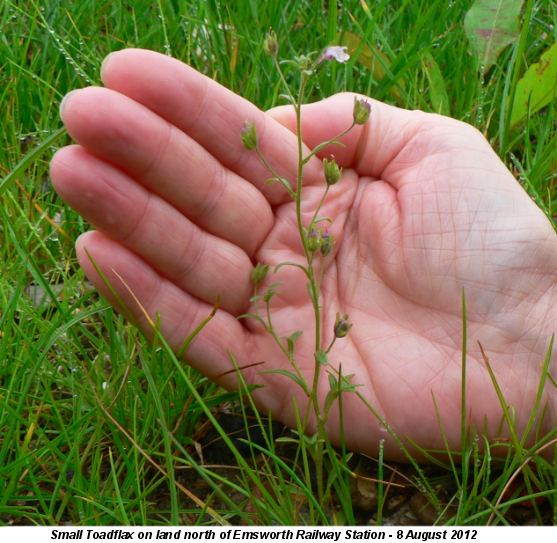
And your Gromwell,
with its pairs of opposite leaves arranged each pair
perpendicular to the last ("decussate"), and leafy
branches arising from their axils, looks exactly like
Red Bartsia (Odontites verna).
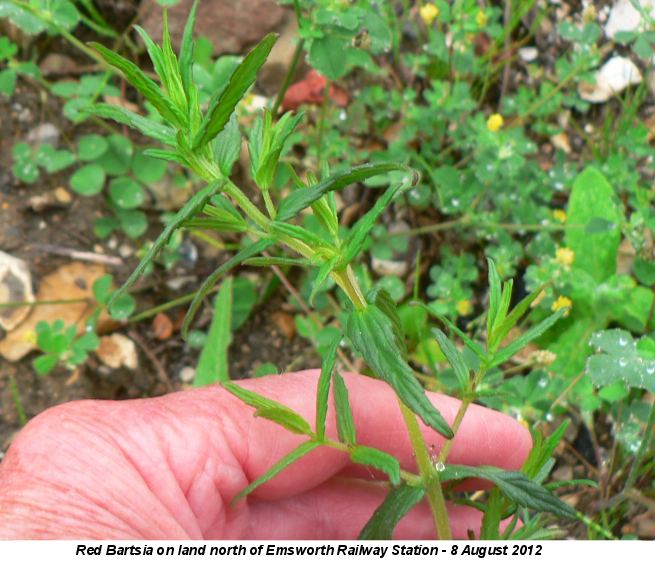
Anyway, still nice
plants to have. And congratulations on your latest
"acquisition". From the range of interesting plants
you've got (including the Toadflax) this sounds like
one you'll have to disturb from time to time if you
want to keep certain things going.
I was looking back at
your earlier picture of "Black Bent-grass" on the
Westbourne Open Space wayside (July 30). I am
wondering about this. Assuming what you meant by that
was Agrostis gigantea, then the panicles look
very broad, open and delicate for that species, which
can occur in disturbed grassland but is more typically
an arable weed and plant of open ground. I think it
more likely you have Common Bent (Agrostis
capillaris). These two can actually be very difficult
to differentiate (especially as they
interbreed)."
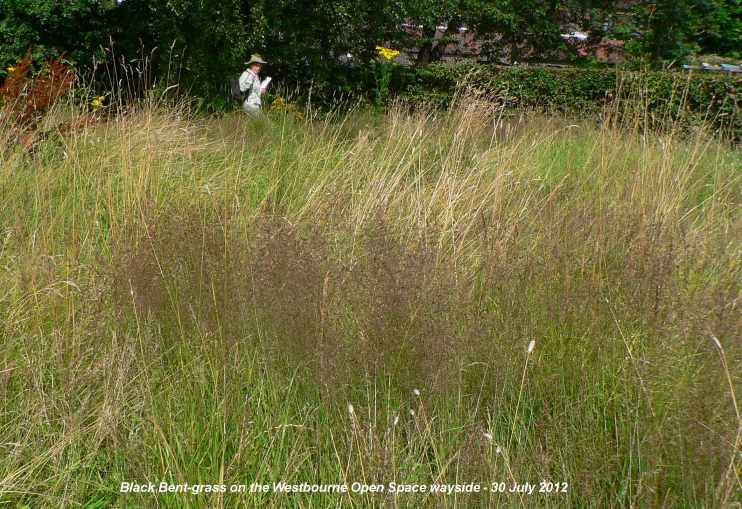
BAT
SURVEY
Nik Knight reports on
his bat survey in the Brook Meadow Peter Pond area on
Monday August 6th. He was acompanied by Lesley Harris
from the Brook Meadow Conservation Group. "There were
both common and soprano pipistrelles around us from
very early on, hence the difficulty of distinguishing
them with the detectors. My summary includes a
sonogram showing the reverse-J shaped pulses of both
of them flying together. We seem to have detected 4
bat species, including the distant bat just north of
the A27 that was probably a serotine and the Myotis
bats at the end. These are likely to have been
Daubenton's bats but unfortunately we couldn't see
them. I've not recorded so much activity at Peter Pond
before."
TUESDAY
AUGUST 7 - 2012
EMSWORTH
Emsworth
Railway Station North
In preparation for an
on site meeting with Terry Green (Southern Railway
Manager) and Lorraine Clode (Emsworth Residents
Association) tomorrow morning, I did a follow-up
survey of the interesting area of land north of the
new ramp at Emsworth Railway Station. It looks a very
promising site for a new wayside, a botanist's
paradise, as good as anything I have seen before in
Emsworth.
The 200+ Marsh
Woundwort is still showing well along with masses of
Common Knapweed, some with rayed flowers. There is a
wonderful mound of mainly Redshank in flower on the
northern track near the A27 road. I discovered a
number of new plants that I missed last time to bring
the total list for this site to 82. The most
interesting find today was a single plant of
Sharp-leaved Fluellen. Not a rare plant,
described in the The Hants Flora as 'locally common'
and found on arable land and on disturbed roadsides.
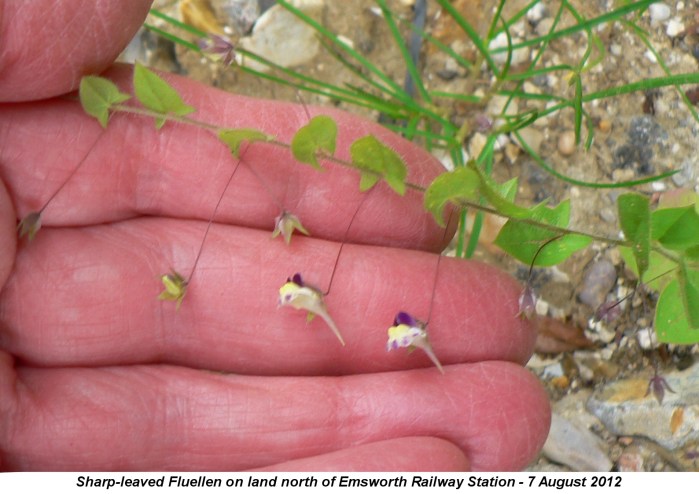
MONDAY
AUGUST 6 - 2012
BROOK
MEADOW
A very tall plant of
Hoary Ragwort (5 feet) is in full flower on the
Seagull Lane patch near the new jubilee hedgerow. I
was surprised to see how much narrower the petals were
than those of Common Ragwort.
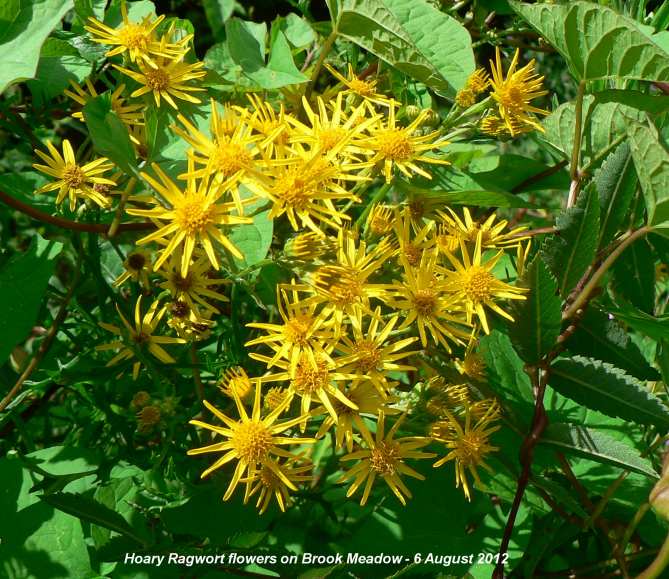
The Fool's Parsley is
all now in flower in this area and Stone Parsley.
Right at the far end of the Seagull Lane patch are two
Yarrow plants with bright pink flowers. I have
a previous record of these plants in this spot in July
2003, but do not recall seeing them here since
then.

Common Fleabane is
flowering much better on the Lumley area this year
than on the orchid area in the north meadow which is
very overgrown. The south eastern corner of the south
meadow has been invaded by Sea Club-rush. This is
probably due to the extreme flooding of this area in
winter months. I came across a fine patch of Water
Mint flowering in the middle of the centre meadow,
attracting lots of Gatekeepers in
particular.
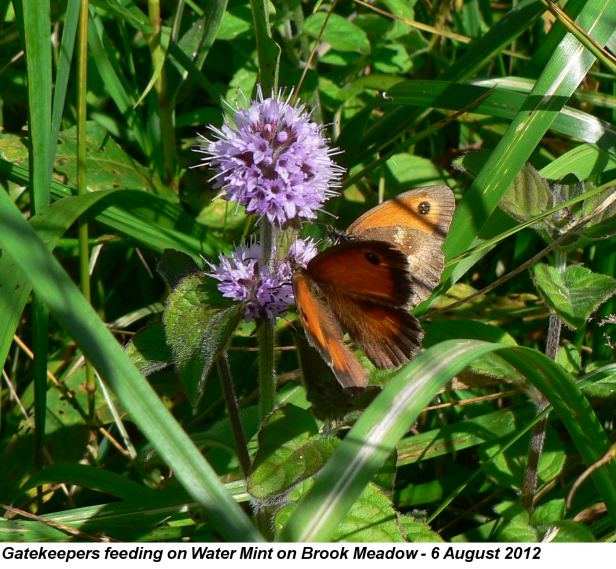
Giant Fescue is
now flowering under the south bridge and on the
Palmer's Road Copse path at its junction with the
central path from the car park.

I saw a brown animal
scuttling around beneath the overhang on the east bank
near the north bend of the river which I am fairly
sure was a Brown Rat and not a Water Vole.
SWIFTS
Small groups of Swifts
(3-4) have been feeding over the houses in Bridge Road
Emsworth for the past few days. These are likely to be
birds passing though on their migration to Africa.
SUNDAY
AUGUST 5 - 2012
BROOK
MEADOW
Conservation
work session
I went over to Brook
Meadow this morning for the regular conservation work
session. My main job was to take photos. I also
pointed out to the volunteers plants that they should
avoid in path clearance, e.g., Strawberry Clover,
Marsh Woundwort.
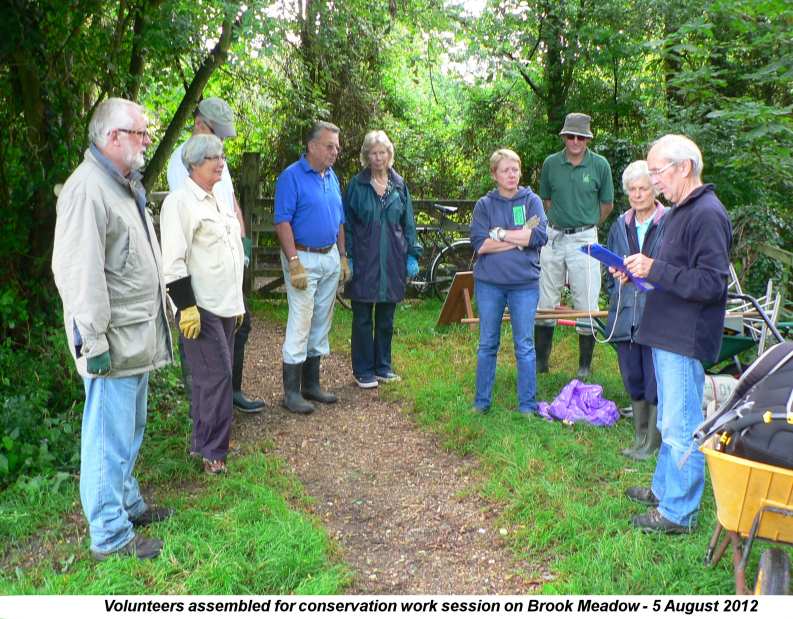
Wild
flowers
There are now five
flower spikes of Marsh Woundwort pushing their
way through a jungle of vegetation at the top of the
Bramble path. I asked Wally Osborne to delay clearing
this area until the autumn to give the seeds time to
set.
Water Mint is
now in flower above the causeway.
There is a rough,
purple flowered Comfrey on the new path on the west
side of the north meadow north of plantation with no
'wings' down the stem which I am fairly sure is
Russian Comfrey.
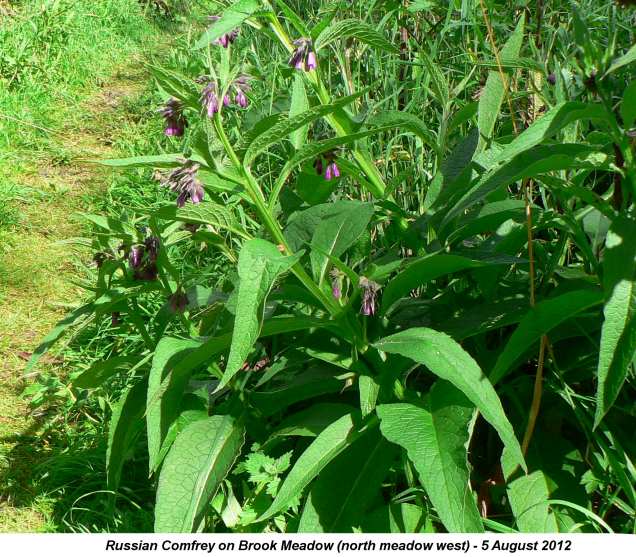
Tufted Hair-grass
is one of the grasses I have been looking for on
Brook Meadow. There has been no sign of it on the
Bramble path but today I did find what looked like
dead panicles of Tufted Hair-grass on the new path on
the west side of the north meadow near the plantation.
The other grass I have been searching for but have not
yet found is Meadow Barley
Kingfishers
While walking over the
north bridge onto the meadow I heard the shrill call
of a Kingfisher and saw it fly beneath the bridge
going north and perch briefly on the first Crack
Willow trunk across the river before continuing its
journey along the river. Pam Phillips also saw a
Kingfisher flying up Lumley Road this morning. These
sightings must indicate the dispersal of birds after
the end of breeding. we should expect to see more as
the autumn progresses.
Southern
Hawker
Two volunteers and I
were 'buzzed' by a Southern Hawker dragonfly along the
Bramble path on the south meadow. The insect perched
just long enough for us to get a good look at its
handsome appearance and for me to get a photo. This
looks like a female or immature.
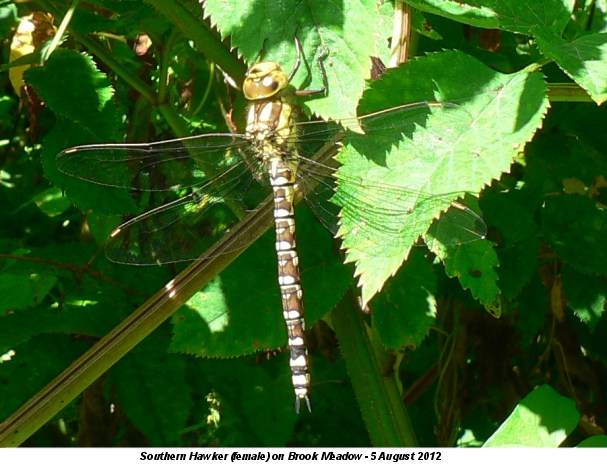
Small
Copper
A Small Copper rested
on the western path through the north meadow allowing
me to get a photo. Small Coppers are regularly seen
every year on Brook Meadow, but not frequently. It has
been recorded already this year. Butterflies missing
from this year's list include Clouded Yellow, Brown
Argus, Small Tortoiseshell and Painted Lady.
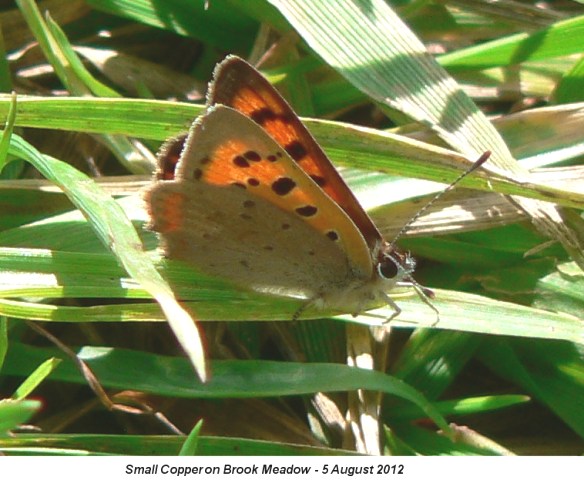
HAVANT
THICKET
The report from
Caroline French of the Havant Wildlife Group walk in
Havant Thicket on Saturday 4th August which includes
interesting sightings and photos of a Drinker moth
(Philudoria potatoria) and a Leopard Slug (Limax
maximus) is now on the Havant Wildlife Group web page
at . . . Saturday
walks - reports 2012
SATURDAY
AUGUST 4 - 2012
BROOK
MEADOW
I had a quick look
around the meadow this evening after getting back from
Rowena Horrocks's 80th birthday party. Pineappleweed
and Lesser Burdock are both out on the path from the
Seagull Lane gate to the north bridge. I found my
first Perforate St John's-wort on Brook Meadow this
year on the round Lumley area path just in front of
the pollarded Black Poplars.
There are some fine
flower heads of Wild Angelica on this path with red
Soldier Beetles and bees feeding. The first
Pepper-saxifrage is opening its tiny flowers on the
east side of the Lumley area. Following a good amount
of searching I finally got my first Marsh Woundwort
on Brook Meadow, flowering in the usual spot at
the northern end of the Bramble path.
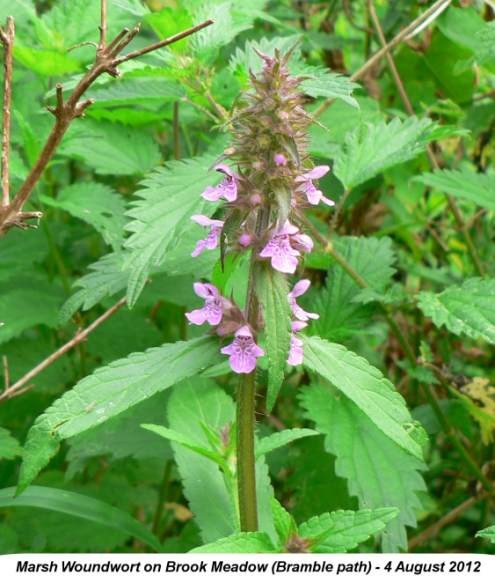
Dragonfly
correction - Black-tailed Skimmer
Yesterday, I spotted a
what I thought was a immature Southern Hawker
dragonfly perched on vegetation on the orchid area.
However, Ralph Hollins corrected this to
female/immature Black-tailed Skimmer. They have a
yellow abdomen with two prominent longitudinal black
bands on the upper surface. The only other confirmed
sighting of a Black-tailed Skimmer on Brook Meadow was
by Bryan Pinchen during his insect survey on
17-Jun-10.
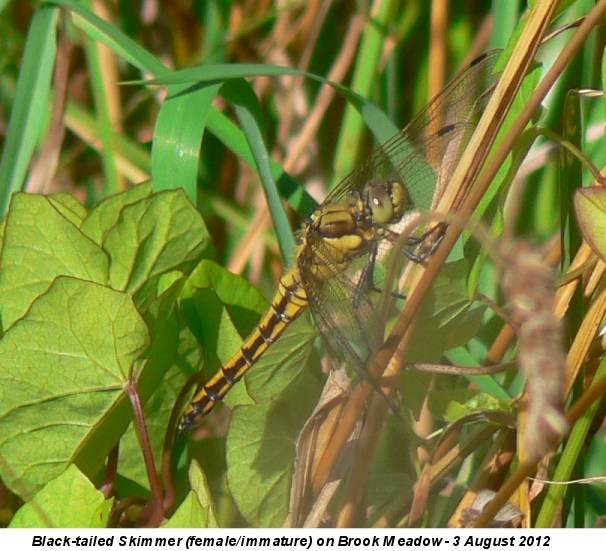
PURPLE
EMPEROR
Andy and Jane Brook
saw what they described as "a huge butterfly flying
along Kings Road, Emsworth, in front of us. It came
down to the road surface just long enough to be
positively identified as a Purple Emperor! We saw both
the upper and under surfaces of the wing at very close
range and could see clearly the markings; there was
not a hint of the purple colour. Its very large size
and colour lead me to conclude that it was a female.
Unfortunately, neither of us had a camera and although
we did go home and grab one we didn't really think
there would be any chance of another sighting because
of the way that it had flown off into the wind with
such strong flight."
The last record I have
of a Purple Emperor in the local area was a photo of a
female taken by Alan Bonner on a wheelie bin in
Southbourne on 23 July 2010. As Andy and Jane did not
get a photo of theirs here is Alan's photo.

Both sexes of this
butterfly look alike except in sunshine when the
male's upper wings turn an iridescent purple. At all
other times the basic colour of both sexes is dusky
with a solid white band across the hindwings and a
patch of white on the forewings. The female is
recognisable by slightly more-rounded wingtips, and
the width of the white band on the hindwing.
After mating females
go off in search of suitable Willows to lay eggs,
sometimes flying considerable distances. The
caterpillar feeds on the leaves of Goat and Grey
Willows and over winters in this stage. So, maybe they
will end up on Brook Meadow?
GODWIT
NEWS
BTO reports - Compared
with many other migratory birds, waders generally
begin moving south quite early. Of the high Arctic
breeding waders, the failed and non-breeding birds are
the first to appear back in Britain and Ireland,
followed by adults that have bred successfully, then
juveniles. Whilst we've been enduring a very wet
summer, Icelandic-breeding waders such as Black-tailed
Godwit have enjoyed relatively warm, dry conditions,
which initiated an early breeding season. Although
pairs that had clutches predated may well have turned
up even earlier than usual this year, the 2012
reporting rate shows a very similar pattern to recent
years. http://ctt-news.org/NXN-WG0H-3GJW16-CNVAN-0/c.aspx
FRIDAY
AUGUST 3 - 2012
SLIPPER
MILLPOND
Great
Black-backed Gulls have gone
When I arrived at the
pond this evening at about 6pm there were no Great
Black-backed Gulls on the pond for the first time
since late April. I scanned to pond and the rafts for
any sign of the chicks, but they had gone. No adults
either. So, that must be that. What a great experience
it has been to watch the development of these
magnificent birds from the egg stage at the end of
April, to their hatching at the end of May and their
first flights in the middle of July. I will need to
check the harbour to see if they are there.
Meanwhile, the
Cormorants are building up on the centre raft where I
counted 10 today.
BROOK
MEADOW
Ragworts
As in previous years,
Hoary Ragwort is fairly abundant on the orchid
area and its flowers are just starting to open. There
are also some north of the causeway.

There are also two
plants of Common Ragwort on the orchid area,
both in full flower, the only ones I have found on
Brook Meadow. Common Ragwort always flowers well
before Hoary. The leaves of the two plants also differ
with those of Hoary Ragwort being more deeply and
narrowly lobed with the end lobe narrow and pointed.

Other
flowers
The bush of Hemp
Agrimony flowers every year in the centre of the
orchid area and is now out and making a good splash of
colour as well as attracting insects. However,
Common Fleabane looks to be struggling with the
vigorous growth of vegetation and bindweed on the
orchid area this year, but looks much better on the
Lumley area. Square-stalked St John's-wort is
flowering well in both the orchid area and the Lumley
area and is already showing its red fruits contrasting
with the yellow flowers. I have yet to find any
Perforate St John's-wort on Brook Meadow this year.
The Lumley area is
particularly rich in flowering plants with Common
Fleabane, Hogweed, Wild Angelica, Square-stalked St
John's-wort, Common Knapweed, Red Bartsia,
Sharp-flowered Rush and Wild Teasel showing very well.
Who has been chopping the flower heads off the teasel?
Strawberry Clover is flowering around the eastern
path.
Insects
Lots of
Gatekeepers were fluttering around, but I did
not see a single Meadow Brown. They seem to fade away
as the Gatekeepers increase.
Plenty of
Meadow Grasshoppers were jumping around in the
orchid area.
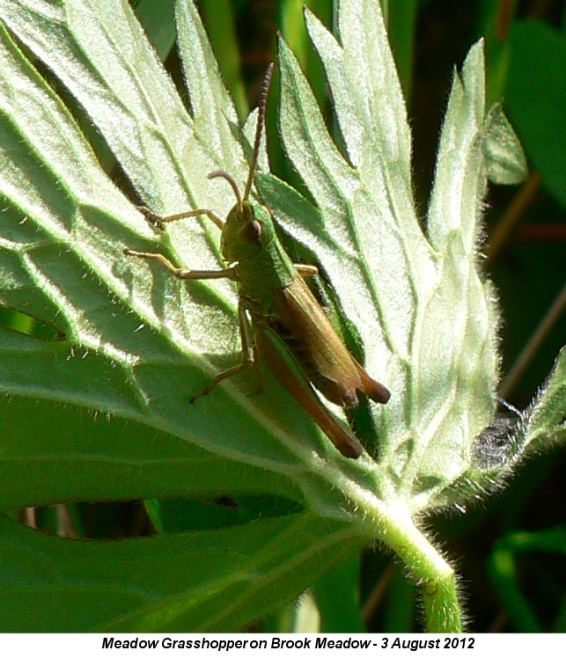
Black-tailed
Skimmer
I spotted a what I
thought was a immature Southern Hawker dragonfly
perched on vegetation on the orchid area. However,
Ralph Hollins corrected this to female/immature
Black-tailed Skimmer. They have a yellow abdomen with
two prominent longitudinal black bands on the upper
surface. The only other confirmed sighting of a
Black-tailed Skimmer on Brook Meadow was by Bryan
Pinchen during his insect survey on 17-Jun-10.

HAVANT
THICKET
Caroline and Ray
French Ray did a recce of Havant Thicket this
afternoon, in preparation for a walk Caroline is
leading there tomorrow. Here is Caroline's report:
"There was very little
about in the way of birds but I did end up with a list
of 12 butterfly species: Red Admiral (1),
Peacock (1), Common or Holly Blue (unable to get a
good enough view to be sure) (1), Marbled White (1),
Gatekeeper (several), Meadow Brown (several), Large
White (1), Small White (1), Small Skipper (2),
Brimstone (1), Speckled Wood (several) and, best of
all, Silver-washed Fritillary (2) (photo attached).
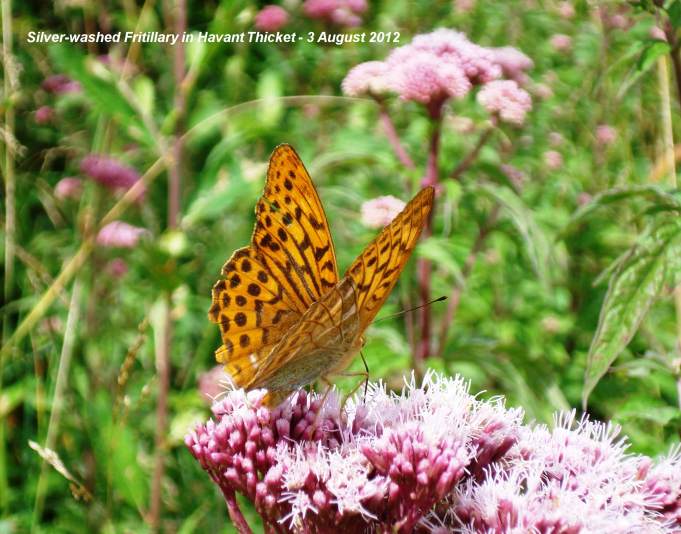
The most exciting
sighting though was a partially-coiled Adder basking
at the edge of a path, which was unfortunately
disturbed by our approach and slithered off before I
could even reach for my camera!
Other observations
included a Roe Deer and a singing Yellowhammer.
Flowering plants were few but included Ling, Bell
Heather, Tormentil, Hemp Agrimony and Betony.
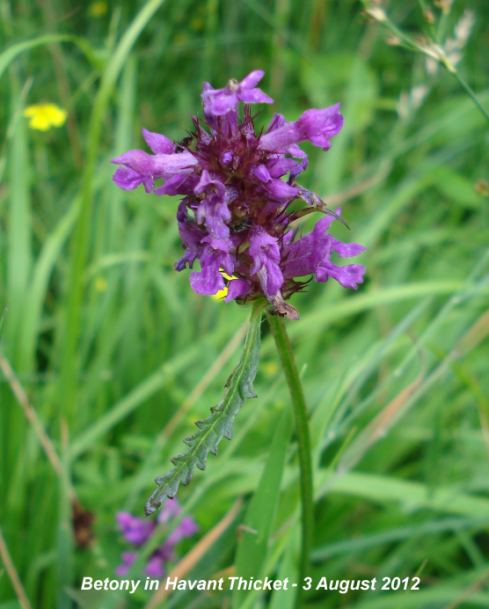
There were also plenty
of large dragonflies flying around - some may have
been Southern Hawkers but I couldn't be
sure.
PS I was lucky to be
up on the South Downs near Twyford yesterday, where
Chalkhill Blues were really abundant.
PPS I have also
attached a photo of a rather sorry-looking Magpie
Moth, rescued from an upsidedown and very sodden
position in the middle of the cycle path alongside
Farlington Marshes. I don't know whether you're
familiar with it but I think it was a new one to me.
It's about the size of a Meadow Brown.

THURSDAY
AUGUST 2 - 2012
EMSWORTH
Slipper
Millpond
The two Great
Black-backed Gull chicks were on the water near
the south raft at 11am this morning with one of their
parents nearby. So, they are still here.
Interestingly, I saw what was probably a pair of Great
Black-backed Gulls near Fowley island in Emsworth
Harbour yesterday during my first ever trip on the
Chichester Harbour Conservancy solar-powered boat. I
wondered at the time if they were the ones from
Slipper Millpond.
The usual six or so
Cormorants were gathered on the centre raft while the
Coots scuttled around happily on the pond.
Swine-cress
I was pleased to
discover Swine-cress (Coronopus squamatus) growing on
the Bridge Road Wayside for the first time. It is
distinguished by the tightly bunched white flowers at
the base of the leaves and the lack of a 'cressy'
small which the more common Lesser Swine-cress has.
Swine-cress is not a first for the waysides as we had
a good crop on the Washington Road path earlier in the
season.
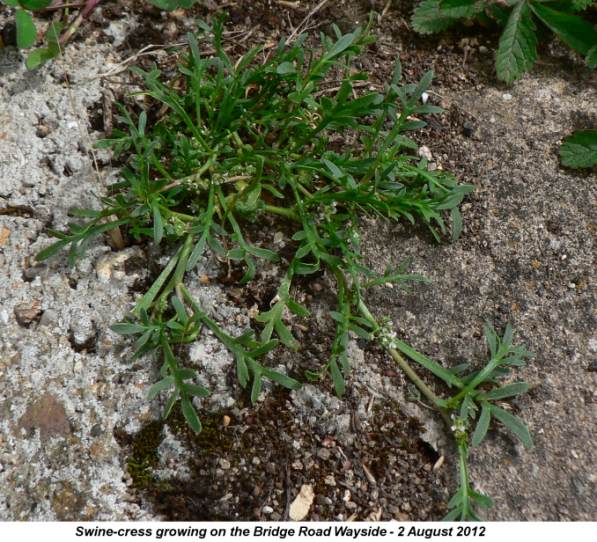
For
earlier observations go to . . . July
16-30